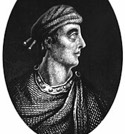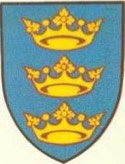Snyder Family 2016 - Person Sheet
Birth921
Death26 May 946, Pucklechurch, Gloucestershire, England
Death Memoage 25
Alias/AKAEadmund I, King of the English; The Elder, “The Deed-Doer”, “The Just” or “The Magnificent”
FatherEdward I "The Elder" King of England (~870-924)
MotherÆlflaeda (Edgiva) Queen of England (<905-968)
Spouses
Birth896, Kent, England
Death18 May 944
Death Memo25 Aug 958??
BurialShaftesbury
FatherSigehelm , Earl Of Kent (871-)
MotherMrs. Sigehelm of Kent (876-)
Marriageabt 940
ChildrenEdgar I "The Peaceable" (~934-975)
Edwy [Æwig], King Of England (ca942-959)
Deathabt 1002
Marriage9443
Notes for Edmund I "The Magnificent" King of England
b. 0921[163]
d. 26 May 0946, Pucklechurch, Gloucestershire, England, Age: 25[163]
EDMUND I
13(940-46 AD)
Son of Edward the Elder, succeeded his half-brother, Æthelstan, with whom he had fought at Brunanburh. Combated the Norse Vikings in Northumbria and subdued them in Cumbria and Strathclyde. He entrusted these lands to an ally, Malcolm I of Scotland. Edmund met his death when he was killed at Pucklechurch, in Gloucestershire, by a robber.
b. 921
d. May 26, 946, Pucklechurch, Eng.byname EDMUND THE DEED-DOER, Latin EDMUNDUS MAGNIFICUS king of the English (939-946), who recaptured areas of northern England that had been occupied by the Vikings.
He was the son of the West Saxon king Edward the Elder (reigned 899-924) and the half brother of King Athelstan (reigned 924-939), under whom the political unification of England had been accomplished. On Athelstan's death (939), Olaf Guthfrithson, the Norse king of Dublin, occupied Northumbria and raided the Midlands.
Edmund recovered the Midlands after Olaf died in 942, and in 944 he regained Northumbria, driving out the Norse kings Olaf Sihtricson and Raegnald. He captured Strathclyde in 945 and entrusted it to Malcolm I, king of Scots, in return for a promise of military support. Thus, Edmund inaugurated a policy of establishing a secure frontier and peaceful relations with Scotland. In addition, his reign marks the beginning of the 10th-century monastic revival in England. The king was killed in his palace by an exiled robber and was succeeded by his brother, Eadred (reigned 946-955); Edmund's sons eventually acceded to power as kings Eadwig (reigned 957-959) and Edgar (reigned 959-975).
d. 26 May 0946, Pucklechurch, Gloucestershire, England, Age: 25[163]
EDMUND I
13(940-46 AD)
Son of Edward the Elder, succeeded his half-brother, Æthelstan, with whom he had fought at Brunanburh. Combated the Norse Vikings in Northumbria and subdued them in Cumbria and Strathclyde. He entrusted these lands to an ally, Malcolm I of Scotland. Edmund met his death when he was killed at Pucklechurch, in Gloucestershire, by a robber.
b. 921
d. May 26, 946, Pucklechurch, Eng.byname EDMUND THE DEED-DOER, Latin EDMUNDUS MAGNIFICUS king of the English (939-946), who recaptured areas of northern England that had been occupied by the Vikings.
He was the son of the West Saxon king Edward the Elder (reigned 899-924) and the half brother of King Athelstan (reigned 924-939), under whom the political unification of England had been accomplished. On Athelstan's death (939), Olaf Guthfrithson, the Norse king of Dublin, occupied Northumbria and raided the Midlands.
Edmund recovered the Midlands after Olaf died in 942, and in 944 he regained Northumbria, driving out the Norse kings Olaf Sihtricson and Raegnald. He captured Strathclyde in 945 and entrusted it to Malcolm I, king of Scots, in return for a promise of military support. Thus, Edmund inaugurated a policy of establishing a secure frontier and peaceful relations with Scotland. In addition, his reign marks the beginning of the 10th-century monastic revival in England. The king was killed in his palace by an exiled robber and was succeeded by his brother, Eadred (reigned 946-955); Edmund's sons eventually acceded to power as kings Eadwig (reigned 957-959) and Edgar (reigned 959-975).
Notes for Ælfgifu (Spouse 1)
Married ABT 905 to , Eadgifu (Edgiva)
Child 14: , Edgifu
Child 15: , Edburga (St.), nun at Nunnaminster
Child 16: , Edmund I the Elder, King of England, b. 921
Child 17: , Eadred, King of England, b. CIR 924
Child 18: , Gregory of Einsiedlen, Abbot of Einsiedlen
aka St. AElfgifu
aka edgiva, queen of england
aka eadgifu (edgiva)
aka elfiva
------------
St. Aelfgith the Younger
(Died AD 944)
St. Aelfgith was the first wife of King Edmund the Magnificent of England. The two were married in around AD 940 and Aelfgith soon became the mother of the future Kings Edwig All-Fair and St. Edgar the Peacemaker. Little is known of her life, but William of Malmesbury tells us how she redeemed condemned men, gave away precious garments to the poor and stoically endured prolonged physical suffering. She is also known to have taken a great interest in Shaftesbury Abbey, where her mother, Winflaeda had been a lay sister. King Edmund is known to have swapped land at Butticanley with some at Tisbury, so that his wife could leave it to the Abbey. What malady afflicted her is unknown, but she died before her husband, on 18th May AD 944 and was buried at Shaftesbury. Soon afterward, a number of invalids were healed at her graveside and she quickly became revered as a saint with a popular cult. She should not be confused with her husband's aunt, St. Aelfgith the Elder.
http://www.earlybritishkingdoms.com/adversaries/bios/aelfgithshaft2.html
Child 14: , Edgifu
Child 15: , Edburga (St.), nun at Nunnaminster
Child 16: , Edmund I the Elder, King of England, b. 921
Child 17: , Eadred, King of England, b. CIR 924
Child 18: , Gregory of Einsiedlen, Abbot of Einsiedlen
aka St. AElfgifu
aka edgiva, queen of england
aka eadgifu (edgiva)
aka elfiva
------------
St. Aelfgith the Younger
(Died AD 944)
St. Aelfgith was the first wife of King Edmund the Magnificent of England. The two were married in around AD 940 and Aelfgith soon became the mother of the future Kings Edwig All-Fair and St. Edgar the Peacemaker. Little is known of her life, but William of Malmesbury tells us how she redeemed condemned men, gave away precious garments to the poor and stoically endured prolonged physical suffering. She is also known to have taken a great interest in Shaftesbury Abbey, where her mother, Winflaeda had been a lay sister. King Edmund is known to have swapped land at Butticanley with some at Tisbury, so that his wife could leave it to the Abbey. What malady afflicted her is unknown, but she died before her husband, on 18th May AD 944 and was buried at Shaftesbury. Soon afterward, a number of invalids were healed at her graveside and she quickly became revered as a saint with a popular cult. She should not be confused with her husband's aunt, St. Aelfgith the Elder.
http://www.earlybritishkingdoms.com/adversaries/bios/aelfgithshaft2.html
Notes for Æthelflæd (Spouse 2)
3Æthelflæd of Damerham
Æthelflæd, known as Æthelflæd of Damerham to distinguish her from other women of the same name, was the second wife of King Edmund I of England.
Æthelflæd was a daughter of ealdorman Ælfgar, probably the ealdorman of Essex. Her mother's name is not recorded. She had at least one brother and at least one sister, Ælfflæd (died circa 1002). Ælfflæd was married to Byrhtnoth, who probably succeeded her father as ealdorman of Essex. Bryhtnoth was killed at the Battle of Maldon in 991. Æthelflæd and Ælfflæd were Ælfgar's heirs at his death, some time between 946 and 951 based on the dating of his will, S1483.
Æthelflæd married Edmund in 944 following the death of his first wife Ælfgifu, mother of the future kings Eadwig and Edgar. She and Edmund are not known to have had any children, and Edmund was killed in 946, leaving Æthelflæd as a wealthy widow. Records of Ely Cathedral, to which she, her sister, and her brother-in-law, were generous benefactors, say that she remarried with an ealdorman named Æthelstan. There were several ealdormen of that name active in the reign of Edmund's brother and successor Eadred, and it most likely that Æthelflæd married the man known as Æthelstan Rota, but it may be that she married Æthelstan Half-King.
Æthelflæd's will survives, S1494, and this, and thus her death, is dated to between 962, and more probably 975, and 991. In addition to gifts to Ely, this endows Glastonbury, Canterbury, Bury, and the family monastery of Stoke-by-Nayland.
Æthelflæd, known as Æthelflæd of Damerham to distinguish her from other women of the same name, was the second wife of King Edmund I of England.
Æthelflæd was a daughter of ealdorman Ælfgar, probably the ealdorman of Essex. Her mother's name is not recorded. She had at least one brother and at least one sister, Ælfflæd (died circa 1002). Ælfflæd was married to Byrhtnoth, who probably succeeded her father as ealdorman of Essex. Bryhtnoth was killed at the Battle of Maldon in 991. Æthelflæd and Ælfflæd were Ælfgar's heirs at his death, some time between 946 and 951 based on the dating of his will, S1483.
Æthelflæd married Edmund in 944 following the death of his first wife Ælfgifu, mother of the future kings Eadwig and Edgar. She and Edmund are not known to have had any children, and Edmund was killed in 946, leaving Æthelflæd as a wealthy widow. Records of Ely Cathedral, to which she, her sister, and her brother-in-law, were generous benefactors, say that she remarried with an ealdorman named Æthelstan. There were several ealdormen of that name active in the reign of Edmund's brother and successor Eadred, and it most likely that Æthelflæd married the man known as Æthelstan Rota, but it may be that she married Æthelstan Half-King.
Æthelflæd's will survives, S1494, and this, and thus her death, is dated to between 962, and more probably 975, and 991. In addition to gifts to Ely, this endows Glastonbury, Canterbury, Bury, and the family monastery of Stoke-by-Nayland.



